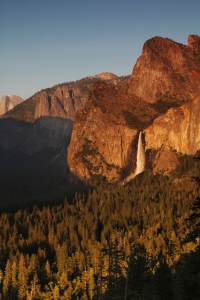
1. A valley that leads to another valley below
2. A cliff or steep wall below the meeting point
The hanging valley picture is of Bridal Veil Falls, Yosemite National Park, California, USA
A hanging valley is elevated above another valley, with one end open to the valley below. There may be a cliff or steep formation where they meet. A river or stream may run through a hanging valley, forming a waterfall that enters the lower valley. Either valley may be U-shaped, if created by glacier activity.
A hanging valley can be formed when the lower valley has a greater rate of erosion. This can be cause by 2 glacier flows, one feeding the other. This may also be caused by a greater flow of water in the lower valley or soft rock layers that erode more quickly. It’s possible that the lower valley may have been formed by glacier flow, and the hanging valley formed more recently by a river or stream.
A hanging valley is usually smaller than the valley below.
Hanging valleys are usually found in mountainous areas.
• Hanging Valleys of Yosemite National Park, California, USA
• Birdman Woman Falls, Glacier National Park, Montana, USA
In Yosemite National Park of California there are many hanging valleys feeding waterfalls that enter the Yosemite Valley below. These include Yosemite Falls, Ribbon Fall, Bridalveil Fall and Illilouette Fall. Yosemite Falls is the highest waterfall in California at 2,425 feet and also has the highest vertical drop in North America at the upper fall which is 1,430 feet high. Ribbon fall has the highest uninterrupted drop at 1612 feet, making contact with the cliff face and not a vertical drop. Bridalveil Fall descends 620 feet into Yosemite Valley and is one of the most impressive. There is a debate about whether glacial activity carved the Yosemite Valley and the hanging valleys in the area. The flow of the Merced River may also be responsible for deepening the Yosemite Valley to create the hanging valleys and waterfalls above. Another example of a hanging valley is found at Glacier National Park in Montana. A hanging valley feeds the Birdman Woman Falls that drop down to Logan Creek in a larger valley below. Glaciers cut and formed both valleys, a smaller glacier in the upper valley feeding the larger glacier down below. A glacier of larger size and depth creates more erosion and cuts deeper into the land.
A valley that opens at one end to another valley below, having a cliff or steep wall below the point where they meet
We want pictures and location of the lanforms around the world and we need your help. Click get started button below.
In Asia, China, India, Nepal, and Bhutan are home to one of the eight wonders of the world and one of the most beautiful mountains in the world, the Himalaya Mountains also called the Himalayas. Boasting as the world’s highest and most famous mountain peak, Mt. Everest. Within the verse of the ‘Kumarsambhava’, Sanskrit […]
Nature have provided us with fascinating landforms and features. The most often adored landforms are volcanoes. Like the perfect cone structure of Mayon Volcano in the Philippines or Mount Fiji in Japan, people look at their beauty and wonder with great appreciation to nature. Volcanoes are mountains with a very disastrous nature. Their only […]
Taal Volcano is the second most active volcano found in the province of Batangas. A complex volcano in the middle of Taal Lake and is often called an island within a lake, that is an island within a lake that is on an island as well as one of the lowest volcano in the […]
Mayon Volcano is one of the active volcanoes in the Philippines. Located in the southern part of Luzon about 473 kilometers (294 miles) from Makati Business District of the Philippines, Mount Mayon is the main landmark of the Province of Albay of Bicol Region. According to local folklore, the volcano was named after Daragang […]
The global temperature and weather is to a large extent a direct result of the sun’s effect to our planet. Together with the atmosphere and the rotation of the earth on its axis. The earth on which weather moves on has its own effect on the weather. The different landforms like mountains, volcanoes, plains, and the […]